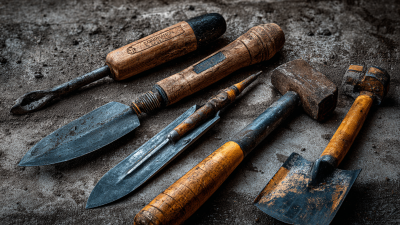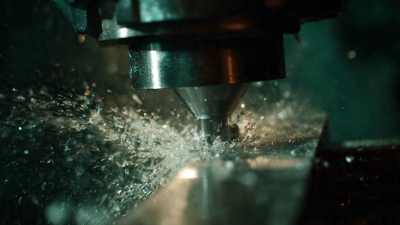Office USA: 706-658-1122 | Tech Support: 706-362-4813
Office Bulgaria: +359 431 64477
Ultimate Guide to Floor Grinding Techniques for a Flawless Finish
Floor grinding is an essential process in achieving a flawless finish for various surfaces, particularly in the construction and renovation industry. According to industry expert John Smith, a seasoned floor grinding technician, “The key to a perfect surface lies in understanding the nuances of each material and applying the right grinding technique.” This insight underscores the importance of mastering floor grinding methods to ensure optimal results.

In this ultimate guide, we will explore various floor grinding techniques that cater to different materials and desired finishes. From concrete to marble, each surface requires a tailored approach to achieve the best outcome. Understanding these techniques not only helps in delivering a high-quality finish but also enhances the longevity and durability of the flooring.
Whether you are a seasoned professional or a newcomer to the floor grinding industry, this guide will provide you with valuable insights and practical tips. By incorporating expert advice and proven methodologies, you can navigate the complexities of floor grinding with confidence, ensuring that every project meets the highest standards of excellence.
Understanding the Basics of Floor Grinding Techniques
Floor grinding is a crucial process in achieving a flawless finish for various types of flooring. As the industry evolves, understanding the fundamentals of floor grinding techniques becomes essential for professionals aiming to deliver high-quality results. According to a report by Research and Markets, the global floor grinding market is projected to grow at a CAGR of 4.5% from 2023 to 2028, emphasizing the importance of efficiency and precision in grinding practices.
At its core, floor grinding involves the use of specialized equipment to smooth surfaces and prepare them for finishing. Techniques such as diamond grinding have gained popularity, as diamonds are known for their hardness and durability, allowing for effective material removal. The American Concrete Institute (ACI) highlights that diamond grinding not only enhances the aesthetic appeal of concrete surfaces but also extends their lifespan when done correctly. Adjusting grinding speed, pressure, and the choice of diamond grit are foundational elements that significantly influence the final outcome.
Furthermore, environmental considerations are driving changes in grinding techniques. The push for green building practices has led to innovations in dust control and the use of eco-friendly materials. According to a study by the Concrete Floor Grinding Association, implementing advanced dust suppression technologies can reduce airborne particles by over 90%, thereby enhancing worker safety and compliance with health regulations. Understanding these basics of floor grinding techniques is essential for any contractor aiming to succeed in the competitive flooring market.
Different Types of Floor Grinders and Their Applications
When it comes to floor grinding, understanding the different types of floor grinders available is essential for achieving a flawless finish. The two main categories of floor grinders are planetary grinders and terrazzo grinders. Planetary grinders are designed to provide an even surface finish and work well on a variety of materials, including concrete and hardwood. On the other hand, terrazzo grinders are specialized machines that focus on restoring and smoothing terrazzo floors, employing specific tooling to polish the surface effectively.
Tips: Always choose the grinder that matches your flooring material to ensure optimal performance. For instance, using a concrete grinder on a wooden floor will not only damage the wood but may also ruin the grinder.
Another type worth mentioning is the handheld grinder, which is perfect for smaller areas and edges. These are particularly useful for tight spots where larger machines can’t operate effectively. When using a handheld grinder, maintain a steady hand and a uniform pressure to avoid gouging or uneven surfaces.
Tips: Always wear appropriate safety gear, including dust masks and goggles, when grinding floors to protect yourself from airborne particles and debris.
Essential Tools and Equipment for Effective Floor Grinding
When it comes to achieving a flawless finish in floor grinding, having the right tools and equipment is crucial. According to a report by the American Concrete Institute, utilizing high-quality grinding machines can enhance productivity by up to 30%. The primary tools for effective floor grinding include diamond grinding pads, which are essential for removing surface imperfections and achieving a smooth finish. These pads come in varying grits; lower grits are ideal for aggressive grinding, while higher grits are perfect for polishing.
In addition to grinding machines and pads, a wet or dry vacuum system is indispensable to maintain a clean working environment. Effective dust control not only improves visibility but also protects the health of workers. A study from the National Institute for Occupational Safety and Health highlighted that using appropriate dust extraction systems can reduce airborne particulate matter by as much as 90%. Investing in these essential tools not only ensures a better finish but also contributes to a safer and more efficient grinding process.
Advanced Techniques for Achieving a Perfect Finish
Achieving a perfect finish when grinding floors requires advanced techniques that can elevate your project from mediocre to exceptional. One key aspect is the selection of the right diamond grinding pads. Using a combination of coarse, medium, and fine grits allows you to gradually smooth the surface, eliminating scratches and imperfections. Start with a coarser grit to remove any major flaws, then work your way through the grits to achieve a polished shine. This progressive approach ensures that the surface is not only smooth but also prepared for the final finishes, such as sealants or coatings.
Tips: Always keep the grinding surface wet to reduce dust and prevent overheating. A consistent application of water not only aids in cooling the pad but also helps capture fine particles, resulting in a cleaner working environment. Additionally, it's essential to maintain an even speed and pressure while grinding. Uneven pressure can lead to inconsistencies in the finish, so take your time to achieve a balanced technique.
Moreover, consider the use of specialized equipment for intricate areas or detailed patterns. Handheld grinders can be particularly useful for corners and edges that larger machines cannot reach. This attention to detail allows for a flawless finish throughout the entire floor, ensuring that every inch meets your high standards of quality.
Common Mistakes to Avoid in Floor Grinding Processes
When it comes to achieving a flawless finish in floor grinding, avoiding common mistakes is crucial. One prevalent error is underestimating the surface preparation. Many beginners jump straight into grinding without adequately cleaning the floor, which can lead to uneven surfaces and inconsistent results. Make sure to remove any debris, dust, or old coatings to create an ideal base for grinding.
Another frequent mistake is using the wrong grinding pads. Each floor type requires specific tools for optimal results. For instance, using too coarse a pad can damage softer materials, while a pad that’s too fine might not adequately remove imperfections. Always consult manufacturer recommendations and consider the type of flooring you’re working with when selecting your grinding pads.
**Tips:** To ensure an even grind, keep the machine moving in a consistent pattern. Avoid lingering too long in one spot, as this can create low spots or grooves in the floor. Additionally, regularly check your equipment for wear and tear; replacing dull pads can significantly improve efficiency and finish quality. By taking these precautions, you can enhance your floor grinding process and achieve a stunning result.
Common Mistakes in Floor Grinding Processes
Related Posts
-

Unlocking the Power: Benefits of Using a Concrete Hand Grinder for Your DIY Projects
-

What is Concrete Grinding and How Does it Transform Surfaces?
-

What is a Concrete Power Trowel and How Does it Work
-

Understanding Global Production Standards for Best Grinding Tools and How to Choose the Right Option
-

10 Best Concrete Tools That Will Transform Your Construction Projects
-

Innovative Solutions for Enhanced Performance in Diamond Tools Industry
